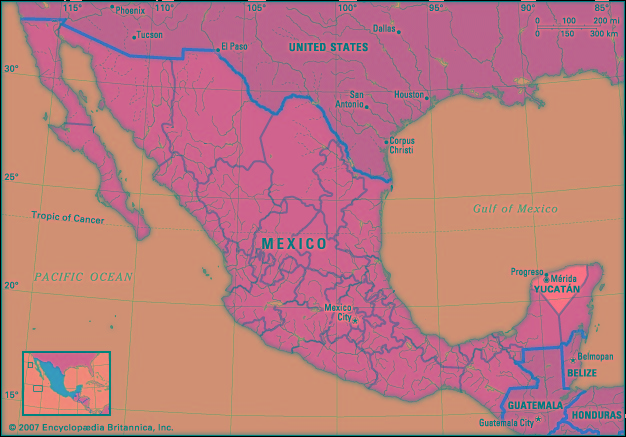Yucatán
state, Mexico

 estado (state), southeastern Mexico. Occupying part of the northern Yucatán Peninsula, it is bounded to the north by the Gulf of Mexico (Mexico, Gulf of), to the east and southeast by the state of Quintana Roo, and to the southwest and west by the state of Campeche. The state capital and chief commercial centre is Mérida.
estado (state), southeastern Mexico. Occupying part of the northern Yucatán Peninsula, it is bounded to the north by the Gulf of Mexico (Mexico, Gulf of), to the east and southeast by the state of Quintana Roo, and to the southwest and west by the state of Campeche. The state capital and chief commercial centre is Mérida. The state's relief includes coastal wetlands, semiarid hills and plains, and limestone lowlands dotted with cenotes (cenote) (water-filled sinkholes). In pre-Hispanic times the peninsula was an Olmec and Maya cultural hearth, as evidenced by the monumental ruins of Chichén Itzá and Uxmal; each has been designated a UNESCO World Heritage site, in 1988 and 1996, respectively. Among the other numerous ruined cities are Chumul, Ek Balam, and Sayil. Strong resistance to the Spanish conquest lasted in the area from 1527 until the 1540s. Yucatán occupied the entire peninsula when it became a state in 1824, but following a series of insurrections, its territory was reduced with the loss of Campeche in 1857 (ratified in 1858) and Quintana Roo in 1902. Later boundary changes reduced the state to its present size.
The state's relief includes coastal wetlands, semiarid hills and plains, and limestone lowlands dotted with cenotes (cenote) (water-filled sinkholes). In pre-Hispanic times the peninsula was an Olmec and Maya cultural hearth, as evidenced by the monumental ruins of Chichén Itzá and Uxmal; each has been designated a UNESCO World Heritage site, in 1988 and 1996, respectively. Among the other numerous ruined cities are Chumul, Ek Balam, and Sayil. Strong resistance to the Spanish conquest lasted in the area from 1527 until the 1540s. Yucatán occupied the entire peninsula when it became a state in 1824, but following a series of insurrections, its territory was reduced with the loss of Campeche in 1857 (ratified in 1858) and Quintana Roo in 1902. Later boundary changes reduced the state to its present size.From the 1880s until the 1950s, the chief crop of the state was henequen, which is extracted from the agave cactus for the manufacture of rope and twine. Most henequen was produced on large plantations and, to a lesser extent from the 1930s, on cooperative ejidos (common lands). Agricultural output now includes grains, tropical fruits, cattle, and pigs. However, services and manufacturing are more important economically. Tourism focused on the pre-Hispanic ruins has increased with the development of railroads, highways, docking facilities for cruise ships at Progreso, and an international airport at Mérida. Since the 1990s, maquiladoras (maquiladora) (export-oriented assembly plants) have created additional employment.
State government is headed by a governor, who is elected to a single six-year term. Members of the unicameral legislature, the State Congress, are elected to three-year terms. Yucatán is divided into local governmental units called municipios (municipalities), each of which is headquartered in a prominent city, town, or village. Although more than four-fifths of the people live in urban areas—notably the Mérida metropolitan area—there are significant numbers of rural Maya who speak little Spanish.
Cultural institutions include Mérida's Autonomous University of Yucatán (founded 1922) and its Regional Museum of Anthropology (1920), with Olmec and Mayan exhibits. Area 14,827 square miles (38,402 square km). Pop. (2000) 1,658,210; (2005) 1,818,948.
- Jean-Baptiste-Étienne-Auguste Charcot
- Jean-Baptist-Point Du Sable
- Jean, baron de Batz
- Jean Bart
- Jean Batten
- Jean Batz, baron de
- Jean Baudrillard
- Jean Berain, the Elder
- Jean Bernard
- Jean-Bertrand Aristide
- Jean Bodin
- Jean Bolland
- Jean Borotra
- Jean Bourgain
- Jean Bullant
- Jean Buridan
- Jean-Bédel Bokassa
- Jean Béliveau
- Jean Calas
- Jean Capréolus
- Jean Casimir-Périer
- Jean Cavalier
- Jean Cayrol
- Jean Chapelain
- Jean Charbonneau